When it comes to serious portable power, few names stand as tall as EcoFlow and Bluetti. If you’ve been searching for a power solution to keep your devices, appliances, or even your entire home running, the EcoFlow Delta Pro Ultra vs. Bluetti AC500 comparison is exactly what you need.
These two titans of portable power stations have a lot in common, but there are key differences that could make one a better fit for your unique needs. We’ll break down the specs and features that matter most, providing the reality of both options. What can these actually power? And for how long?
Let’s see if the EcoFlow Delta Pro Ultra is better than the Bluetti AC500.
We carefully select the products and services we link to. If you buy through our links, we may earn a commission. There’s no extra cost to you and it helps us provide this information.

Quick Breakdown: Supreme Size or Massive Yet Manageable
EcoFlow and Bluetti are two of the biggest names in portable power, known for offering reliable energy solutions across a wide range of products.
The EcoFlow Delta Pro Ultra sits at the top of EcoFlow’s lineup, delivering the brand’s highest battery capacity. It’s built for serious power needs, although it’s not the most compact option. On the Bluetti side, the AC500 isn’t their most powerful unit. But the only ones above it are either (1) a stationary power system or (2) a power station with limited modular expansion. For those reasons, the AC500 is considered Bluetti’s best and most powerful portable power station.
These two giants are heavy hitters for anyone considering bigtime portable or home backup power. They both offer larger batteries, powerful inverters, and extensive outlets, including high-amp options ideal for powering a home transfer switch or RV shore power inlet. In many ways, these are very similar systems.
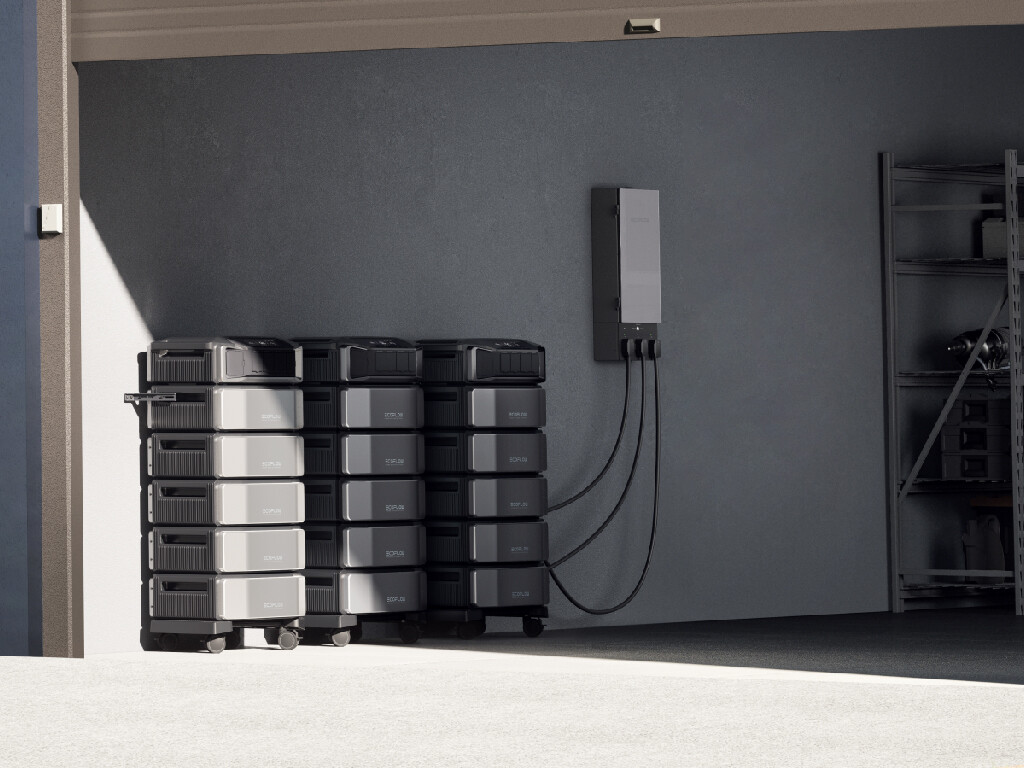
However, the EcoFlow Delta Pro Ultra (DPU) crosses the finish line well ahead of the Bluetti AC500. It’s simply a much more powerful single-unit system with absolutely mind-boggling modular expansion potential. Here are the Delta Pro Ultra’s standout features:
- More battery capacity and inverter power
- Superior UPS function and 240V output with one unit
- Intelligent home integration capability with EcoFlow Smart Panel
The Bluetti AC500 may not match the insane specs of the PDU, but it’s still an unbelievably capable system that can’t be ignored. For some people, the Bluetti AC500 is the better purchase. It offers:
- More high-amp outputs and DC ports
- Slightly smaller and more manageable system
- Lower starting price yet still powerful and with modular expansion potential
While the battery sizes and inverter specs are two of the biggest differences, these two options are quite similar in almost every other way. The EcoFlow offering 240V output from one unit is perhaps the biggest difference. The AC500 can do it, but you need two units.
When it comes to value, the EcoFlow Delta Pro Ultra is on the pricier side with a higher minimum cost. But you’re paying for the sheer power and features it offers. Meanwhile, the Bluetti AC500 has a slightly lower starting cost.
Comparing the price per battery Wh can help equalize the comparison. The Bluetti’s MSRP is higher than we like to see (around $1.30 per Wh), but the AC500 and Delta Pro Ultra are usually sold at discounted prices and both are typically around $0.90 per Wh or less – which is about as good as you can get for power stations. Bottom line, they’re both great values but the EcoFlow has a higher starting cost.
Don’t forget to include the 30% solar tax credit when shopping for power stations with batteries over 3kWh.
Ultimately, choosing between these two comes down to your priorities. If sheer power with maximum potential specs are key, the EcoFlow Delta Pro Ultra is your go-to. It’s all-around more powerful and offers 240V output from just one unit. But if you want to keep costs down a little yet still get a powerful system that can grow with your needs, the Bluetti AC500 might be the smarter pick. Either way, both power stations are well worth the buy.
Save 5% on most EcoFlow orders with SOLARWAY5OFF discount code.

|
EcoFlow DELTA Pro Ultra |
DPU on EcoFlow DPU on Amazon |
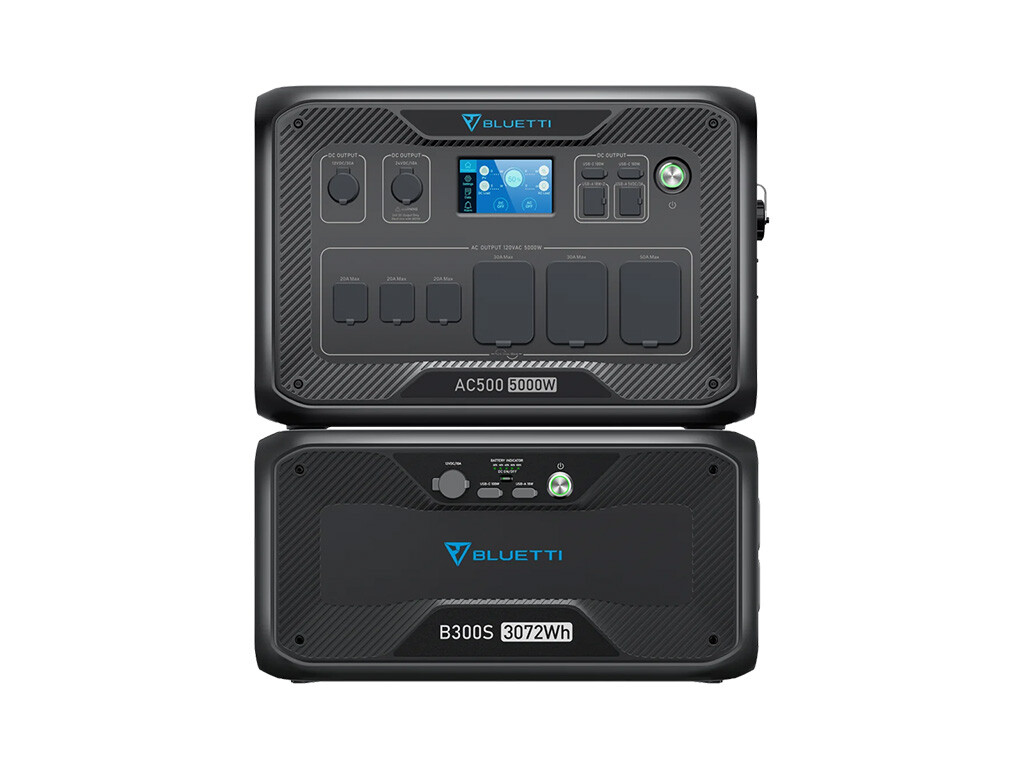
|
BLUETTI AC500 |
AC500 on Bluetti AC500 on Amazon |
Detailed Showdown: EcoFlow Delta Pro Ultra vs. Bluetti AC500
These heavy-duty power stations are designed to handle full home backup in emergencies as well as RV adventures and off-grid living. This breakdown will help you decide which one is better for your needs. We’ll analyze key features and specs, while providing the reality of what these can actually power and for how long.
This is the real information you need to make an informed decision based on facts, not marketing claims.
Here’s a look at what we’ll explore:
- What Can These Inverters Power?
- How Long Does the Battery Power Last?
- How Quickly Do They Charge?
- Can You Move Them Easily?
- Full Specs Charts
- Which is the Best Buy?
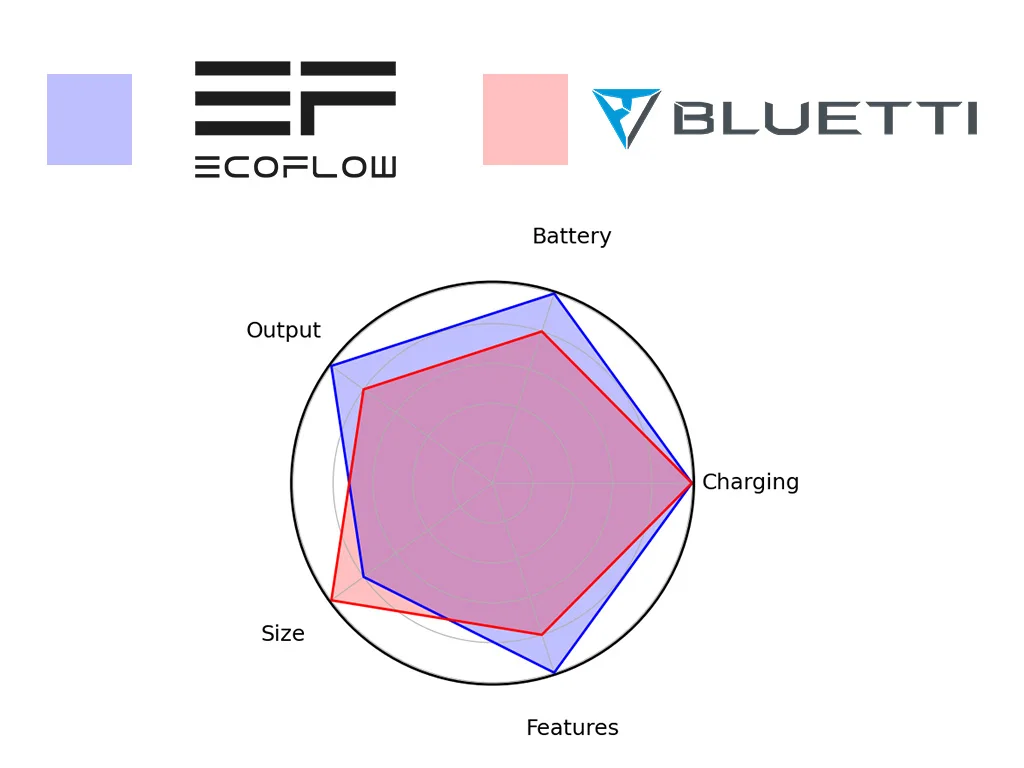
Powering It All: The Real Difference in Inverters and Outlets
These brands prominently display the inverter power specs. But they rarely describe what the inverter is or what that really means for your use. The inverter turns the battery’s direct current (DC) power into the alternating current (AC) power you get from most outlets. You’ll also want to make sure the power station has enough AC outlets and DC ports for your needs.
The higher the inverter rating, the more energy the power station can deliver at one time. More wattage means more devices. Or more powerful appliances. And for these whole-home solutions, the inverter size is critical.
When comparing the EcoFlow Delta Pro Ultra and Bluetti AC500, you’re going to find that both have truly incredible inverters. But not identical.
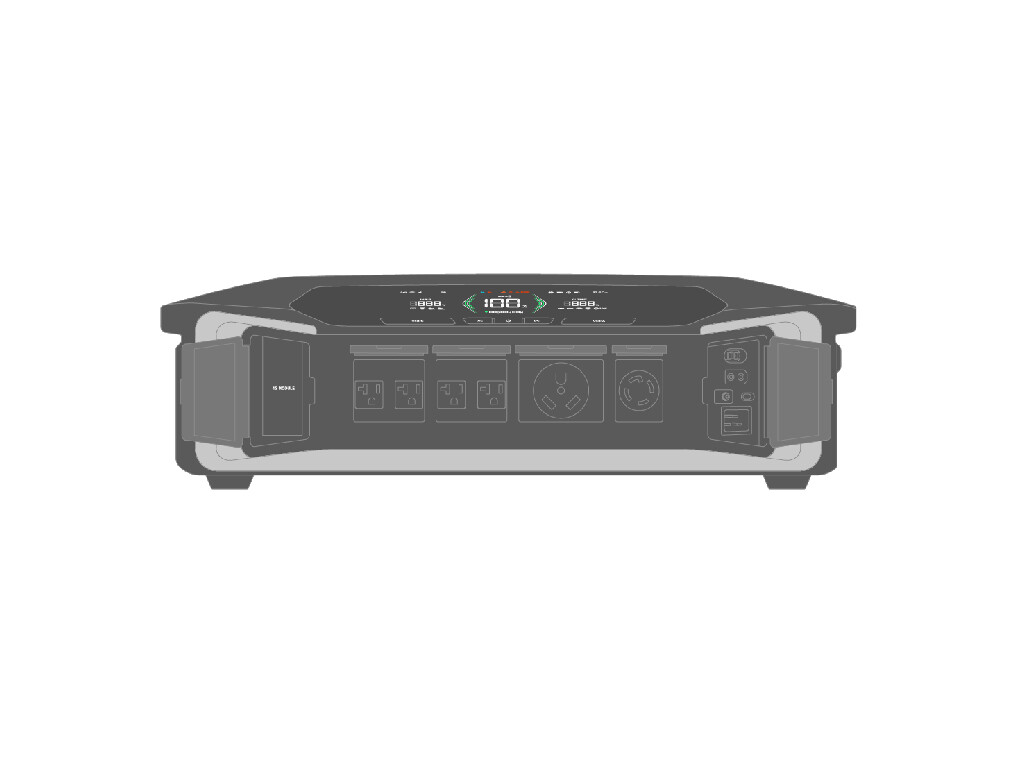
The Delta Pro Ultra offers a massive 7,200W inverter with a unique advantage: it can output 240V power directly from a single unit. This makes it ideal for powering large appliances like electric dryers, air conditioners, or even an entire home’s essential circuits. It also includes a high-amp 30A outlet, a great fit for RVs. However, EcoFlow skimps a bit on DC outputs lacking a cigarette lighter port, which could be a downside if you’re looking to run smaller devices like portable refrigerators.
On the other hand, the Bluetti AC500 packs a punch with its 5,000W inverter and can reach 240V output – but only when you connect two units together. This modular setup is great if you need flexibility and scalability, but it adds complexity (and cost) if you need higher voltage. Bluetti shines in DC outputs, offering a car cigarette lighter port and two wireless charging pads. This makes it excellent for directly powering smaller electronics, portable gear, and car accessories, which is ideal for device-packed camping setups. And the AC500 has two high-amp AC outlets, including 30-amp style and 50-amp style.
Both of these power stations offer a high-amp DC output as well through an 30-amp Anderson port. These can be very useful for powering an entire DC fuse box, connected to a bunch of DC devices.
Here’s a quick look at how these inverters and outlets translate into real-world use:
- EcoFlow Delta Pro Ultra
- 240V power from a single unit
- High-amp 30A outlet for RV and home transfer switches
- Best for large appliances (fridges, dryers, whole-home backup)
- Bluetti AC500
- 240V output requires two units
- Two high-amp AC outputs (30-amp and 50-amp) plus more DC options
- Still ideal for home transfer switches and RV shore power inlets

The other factor here is the modular expansion. EcoFlow shoots into the stratosphere by allowing three Delta Pro Ultra units to combine for a jaw-dropping 21.6kW of AC output. This is far more than most homes ever need. We typically recommend one unit or two if you have very serious power needs.
The Bluetti AC500 can use two units together. This not only achieves the 240V output which can be vital for powering certain appliances, but it also doubles the inverter output to a very impressive 10kW. When it comes to home backup needs, 10kW is usually more than sufficient.
Here’s a breakdown of real-world usage that these inverters can handle:
- Low-watt devices (100W or less): Laptops, phones, WiFi router, lights.
- Handled with ease by both.
- Medium-watt devices (200W-500W): TVs, fridges, desktop computers.
- Both stations can handle these without much of a concern.
- High-watt devices (1,000W-2,000W): Power tools, microwaves, coffee makers
- Running more than one of these simultaneously starts may cut the Bluetti a little close to the top, but the EcoFlow’s 7.2kW can usually handle these without a problem.
- Heavy-duty appliances (3,000W or more): Whole-home air conditioners, electric dryers.
- The Delta Pro Ultra is better suited to handle these straight out of the box, while Bluetti may struggle and require a second unit to provide 240V power. Startup surges can also pose additional challenges here (soft start devices may help)..
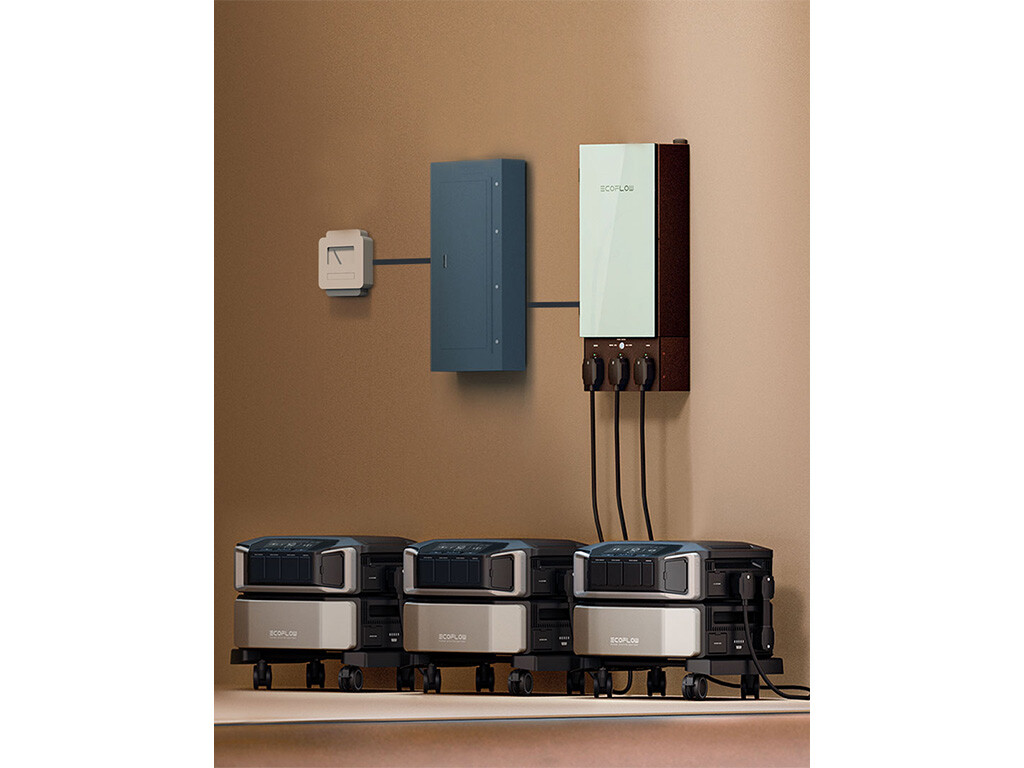
If you’re considering home integration, the EcoFlow Delta Pro Ultra is the more convenient choice. While both can use the high-amp outputs to power a universal transfer switch (manual or automatic), the EcoFlow Smart Home Panel 2 is an amazing device that’s worth attention. It transforms the connection between your home and the DPU units into an intelligent system that you have full control over, through the EcoFlow app from anywhere in the world. Remotely change settings, monitor usage, and make sure power is being delivered exactly how you want it.
Both of these can also serve RV needs extremely well. You don’t even have to make any major modifications. Just use the high-amp outputs of these units to run the shore power inlet of your RV. If you want to make it so you don’t have to route an exterior cable, you can install a second shore power inlet – which is a relatively small addition that almost any RV shop should be able to handle.
When it comes to Uninterruptible Power Supply (UPS) functions, the Delta Pro Ultra outperforms the Bluetti with its online UPS (0ms transfer time) through some ports. It switches to battery power instantly when the grid fails. The AC500 isn’t far behind, with a respectable 20ms transfer time (also found on other EcoFlow ports), which works for most home uses but could cause a brief power flicker with sensitive devices. The Bluetti EP500Pro is another power station to consider with online UPS.
Output Verdict: The EcoFlow Delta Pro Ultra wins this round, thanks to its ability to output 240V power, handle large appliances with a single unit, and simply unbeatable 21.6kW max output. It’s the superior choice for large home backup needs, running multiple heavy-duty devices at once. However, the Bluetti AC500 still excels as a home backup solution with 5kW inverter that’s suitable for a comfortable home backup situation and 10kW inverter with two units, offering 240V output. It also offers a wider range of DC outputs that can make it easier to power devices while on the go.
| Product | EcoFlow DELTA Pro Ultra | Bluetti AC500 |
|---|---|---|
| AC Output | 7,200W | 5,000W |
| AC Output (System Max) | 21,600W | 10,000W |
| 120V Outlets | 5 (4x20A, 1x30A) | 6 total (3x20A; 2x30A; 1x50A) |
| 240V Outlets | 1x30A | – |
| UPS / EPS | 0ms / 20ms | 20ms |
| USB-A Ports | 2x15W | 2x15W; 2x18W |
| USB-C Ports | 2x100W | 2x100W |
| Other DC (Anderson or other) | 1x378W (30A) | 30A |
| Cigarette Lighter | – | 1x240W |
| Wireless Charging Pad | – | 2x15W |
| Connectivity | WiFi / Bluetooth / 4G | WiFi / Bluetooth |
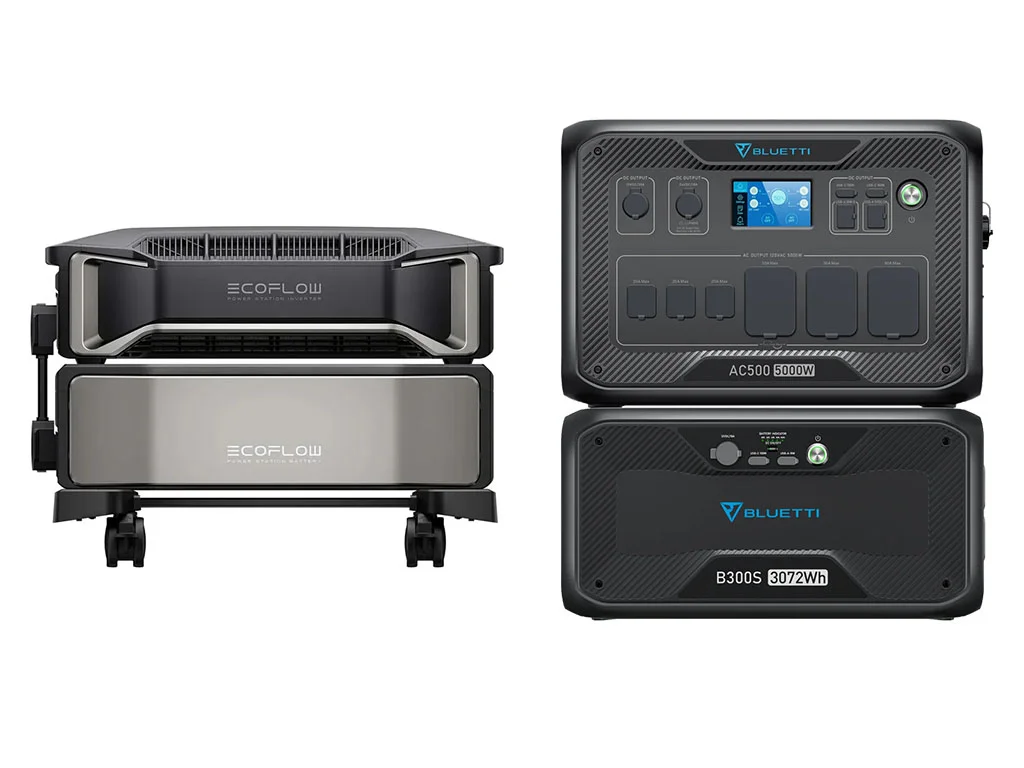
Power to Last: Battery Capacity and Performance
The size of the battery determines how long you can keep your devices running. Both the EcoFlow Delta Pro Ultra and Bluetti AC500 pack impressive watt-hour (Wh) capacities, giving you hours of backup power for everything from camping to home emergencies.
Here’s what the minimum systems for these two power stations look like in real-life usage:
- Power a 60W laptop: 80 hours (Delta Pro Ultra); 40 hours (AC500)
- Run a group of devices with 600W total: 8 hours (Delta Pro Ultra); 4 hours (AC500)
If you start adding in large heavy-duty appliances (like an air conditioner), these numbers plummet. Air conditioning and electric heat (like induction cooktops) take a lot of energy. That’s where the modular expansion of these power stations comes into play.
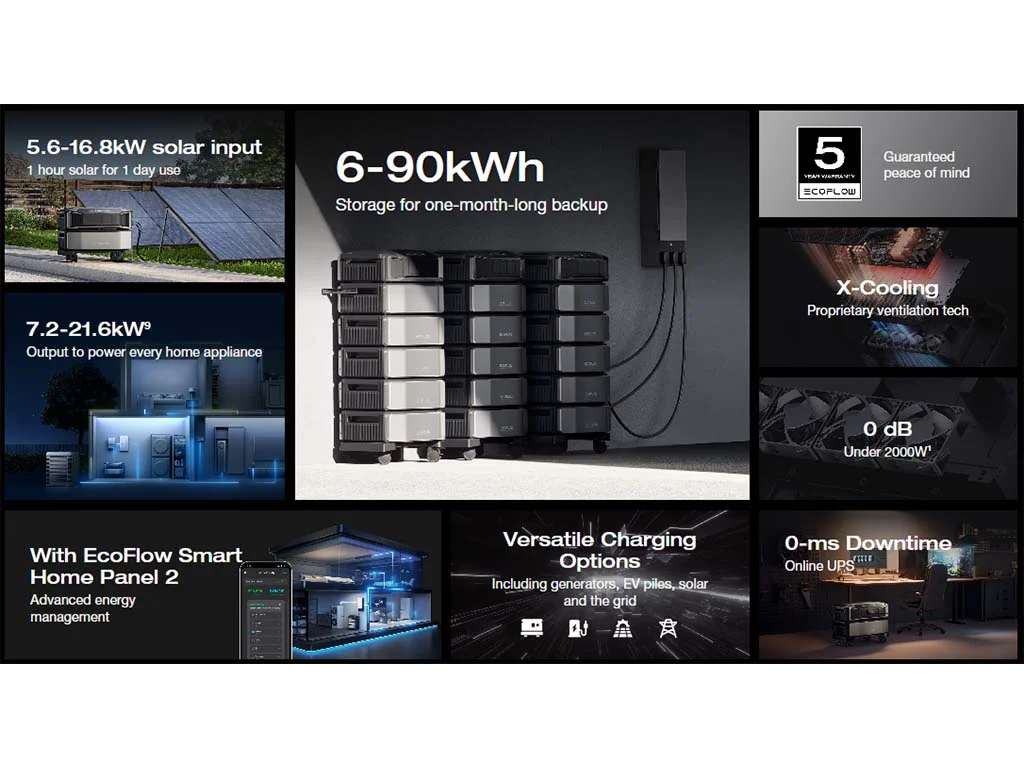
The Delta Pro Ultra is equipped with a 6,000Wh LiFePO4 (LFP) battery, which can be expanded up to 90,000Wh with extra units. As you may expect by now, this 90kWh capacity is absolutely massive, able to power most homes in backup situations for weeks on end or multiple days without sacrificing any usage and using zero charging.
The Bluetti AC500, on the other hand, starts with a smaller 3,072Wh battery, but it’s also modular. You can expand its capacity up to 36,864Wh by adding extra battery packs. For many people including RV enthusiasts or home backup needs, a 36.9kWh battery is more than enough. While smaller than the EcoFlow, don’t underestimate this massive Bluetti system.
Both units use LiFePO4 batteries, known for their long life cycles. You can charge and discharge the EcoFlow over 3,000 cycles and 3,500 cycles for Bluetti before they start losing significant capacity. To put that in perspective, that’s daily use for nearly 10 years. This makes them a long-term investment in energy independence, backed by solid warranties: five years for EcoFlow and four years for Bluetti.
Battery Verdict: The EcoFlow Delta Pro Ultra has the higher capacity and sheer scalability. With its 6,000Wh battery and potential expansion up to 90,000Wh, it offers unbeatable battery power. The Bluetti AC500 still has plenty of juice to dish out with 3kWh batter per unit and nearly 37kWh possible with extra batteries. Although the massive capacity of the EcoFlow provides the longest-lasting battery power, many people will be perfectly happy with the AC500.
| Product | EcoFlow DELTA Pro Ultra | Bluetti AC500 |
|---|---|---|
| Battery | 6,000Wh | 3,072Wh |
| Battery (System Max) | 90,000Wh | 36,864Wh |
| Warranty | 5 years | 4 years |
| Battery Type | LiFePO4 / LFP | LiFePO4 / LFP |
| Battery Cycles | >3,000 | >3,500 |
| Buy Now | Buy DPU | Buy AC500 |
| Buy on Amazon | EcoFlow DPU on Amazon | Bluetti AC500 on Amazon |

Charging Up Fast: Speed and Input Options
The ability to quickly top off your power station between uses can make all the difference, whether you’re preparing for a storm, in the midst of an outage, or on an adventure away from it all. Both the EcoFlow Delta Pro Ultra and Bluetti AC500 offer a variety of ways to recharge, from plugging into the wall to harnessing the sun’s energy with solar panels.
The higher the input wattage, the faster you can get back to full power.
Let’s break down the charging speeds:
- AC Charging:
- EcoFlow Delta Pro Ultra: Charges at a blazing 7,200W from AC power (if you can find a source that strong), theoretically topping off in 1 hour.
- Bluetti AC500: Handles up to 5,000W of AC input, taking about 1.2 hours to fully charge.
- Standard household outlets are 120V / 15A, which is a max output of 1,800W. Both will take longer to charge unless you’re using high-amp or high-voltage outlets.
- Solar Input:
- EcoFlow Delta Pro Ultra: Has dual inputs for 5,600W total, charging in around 1.3 hours with optimal conditions. One input has a 450V maximum, making it very easy to connect panels in series and maximize solar charging without damaging the power station.
- Bluetti AC500: Can handle up to 3,000W of solar, taking about 1.2 hours to recharge despite the lower input, thanks to its smaller battery size.
- Both stations balance solar input with battery size very well, making them efficient when charging off-grid.

Car charging is not usually practical for these large units, as 12V charging from a standard cigarette lighter port only delivers about 120W. However, the Bluetti Alternator Charger 1 can ramp up to 560W by using your car or RV’s engine and electrical power generated while driving. It’s much better than nothing. And this Bluetti device is universal – it uses standard solar MC4 connectors as the output, so the EcoFlow can use it too. There is an EcoFlow Alternator Charger as well, but it features proprietary connectors that are not compatible with the DPU (only smaller units like the EcoFlow Delta Pro 3).
Charging Verdict: The EcoFlow Delta Pro Ultra slightly edges out the Bluetti AC500 in AC and solar input capacity, meaning it can charge faster in a perfect setup. However, both power stations are very close in real-world performance when you factor in battery size and charging rate. Whether you’re relying on AC power or the sun, both stations offer exceptional charging capabilities and are well-balanced for fast recharging.
| Product | EcoFlow DELTA Pro Ultra | Bluetti AC500 |
|---|---|---|
| AC Input | 7,200W | 5,000W |
| AC Recharge Hours (Est.) | 1h | 0.7h |
| Solar Input | 5,600W | 3,000W |
| Solar Recharge Hours (Est.) | 1.3h | 1.2h |
| Solar Input (System Max) | 16,800W | 6,000W |
| Solar Input 1 Watts | 4000W | 3000W |
| Solar Input 1 Volts Min | 80V | 12V |
| Solar Input 1 Volts Max | 450V | 150V |
| Solar Input 1 Amps | 15A | 15A |
| Solar Input 2 Watts | 1600W | – |
| Solar Input 2 Volts Min | 30V | – |
| Solar Input 2 Volts Max | 150V | – |
| Solar Input 2 Amps | 15A | – |

Size and Portability: How Heavy Are They?
One of the key benefits of portable power stations over DIY systems is that they’re easy to take with you. Whether you’re off on a road trip, RV adventure, or just need backup power at home, this portability can be very handy.
Both of these are heavy-duty and heavyweight power stations. Yet these two also share a unique design element that helps reduce the burden of moving them around: the inverter units and battery units are always separate. That makes both much lighter to handle, although the downside is that you always need two units to provide any power: the inverter and the battery.
With its superior capabilities, it’s no surprise that the EcoFlow Delta Pro Ultra and its batteries are the heavier of the two. The inverter unit weighs about 70 lbs (32 kg) while each battery pushes the scales over 100 lbs (45 kg).
The Bluetti AC500 system is slightly more manageable with 66 lbs (30 kg) for the inverter and batteries weighing closer to 80 lbs (36 kg). Still not exactly something you’ll want to mess with every day, but 80 lbs is a lot easier to work with the >100 lbs.
Portability Verdict: The Bluetti AC500 edges out the EcoFlow Delta Pro Ultra in terms of weight and overall portability, making it the better option for on-the-go power. However, the Delta Pro Ultra has the advantage of an organized stacking system and a wheeled cart for easier movement in larger setups. Both keep the inverter and battery units separate to make moving these beastly power stations a little easier (especially when compared to other brands, like the 130 lbs Anker F3800).
| Product | EcoFlow DELTA Pro Ultra | Bluetti AC500 |
|---|---|---|
| Weight (lbs) | 70lbs | 66.2lbs |
| Weight (kg) | 31.7kg | 30kg |
| Dimensions (in) | 27.2×18.9×8.4in | 20.5×12.8×14.1in |
| Dimensions (mm) | 690x481x214mm | 520x325x358mm |
Full Specs Comparison Chart
Check out the EcoFlow Delta Pro Ultra and Bluetti AC500 spec comparison chart to see the side-by-side matchup. We’ve also included links to the official user manuals for both power stations so you can answer any lingering questions.
| Product | EcoFlow DELTA Pro Ultra | Bluetti AC500 |
|---|---|---|
| Battery | 6,000Wh | 3,072Wh |
| Battery (System Max) | 90,000Wh | 36,864Wh |
| AC Output | 7,200W | 5,000W |
| AC Output (System Max) | 21,600W | 10,000W |
| AC Input | 7,200W | 5,000W |
| AC Recharge Hours (Est.) | 1h | 0.7h |
| Solar Input | 5,600W | 3,000W |
| Solar Recharge Hours (Est.) | 1.3h | 1.2h |
| Solar Input (System Max) | 16,800W | 6,000W |
| Warranty | 5 years | 4 years |
| Weight (lbs) | 70lbs | 66.2lbs |
| Weight (kg) | 31.7kg | 30kg |
| Dimensions (in) | 27.2×18.9×8.4in | 20.5×12.8×14.1in |
| Dimensions (mm) | 690x481x214mm | 520x325x358mm |
| Solar Input 1 Watts | 4000W | 3000W |
| Solar Input 1 Volts Min | 80V | 12V |
| Solar Input 1 Volts Max | 450V | 150V |
| Solar Input 1 Amps | 15A | 15A |
| Solar Input 2 Watts | 1600W | – |
| Solar Input 2 Volts Min | 30V | – |
| Solar Input 2 Volts Max | 150V | – |
| Solar Input 2 Amps | 15A | – |
| Battery Type | LiFePO4 / LFP | LiFePO4 / LFP |
| Battery Cycles | >3,000 | >3,500 |
| 120V Outlets | 5 (4x20A, 1x30A) | 6 total (3x20A; 2x30A; 1x50A) |
| 240V Outlets | 1x30A | – |
| UPS / EPS | 0ms / 20ms | 20ms |
| USB-A Ports | 2x15W | 2x15W; 2x18W |
| USB-C Ports | 2x100W | 2x100W |
| Other DC (Anderson or other) | 1x378W (30A) | 30A |
| Cigarette Lighter | – | 1x240W |
| Wireless Charging Pad | – | 2x15W |
| Connectivity | WiFi / Bluetooth / 4G | WiFi / Bluetooth |
| User Manual | User Manual | User Manual |
| Buy Now | Buy DPU | Buy AC500 |
| Buy on Amazon | EcoFlow DPU on Amazon | Bluetti AC500 on Amazon |

Final Verdict: Our Top Choice
After diving deep into the details, the choice between the EcoFlow Delta Pro Ultra and the Bluetti AC500 may seem clear. The DPU is simply much more powerful and capable. But it’s not really that simple. There’s absolutely nothing dainty about the Bluetti AC500. It still packs a punch and includes modular expansion that goes beyond what most people will use.
However, we have no choice but to find the EcoFlow Delta Pro Ultra as the superior choice. It’s better for those who need high power capacity and seamless integration into home backup setups. It’s built for running large appliances or handling long off-grid situations. With single-unit 240V output and the EcoFlow Smart Home Panel 2, there are some things that Bluetti can’t match.
For those that want a lower starting price and will stay within the maximum specs, the Bluetti AC500 is a great choice as well. While its ability to grow over time isn’t as massive as the DPU, it’s still packed with high-amp outputs. And it has the advantage of being slightly lighter with a wider array of DC outputs, including wireless charging pads. The shorter warranty coverage does sting a bit though.
| EcoFlow Delta Pro Ultra | Bluetti AC500 |
|---|---|
Here’s a quick recap of the key points:
- Inverter and Outputs: The Delta Pro Ultra takes the lead with its 7.2kW inverter, direct 240V output, and max output of 21.6kW. It’s superior for large appliances and energy-intensive home power. While capable with a 5kW inverter and 10kW max, the AC500 requires two units for 240 yet includes more DC outputs.
- Battery Capacity: The Delta Pro Ultra has a larger 6,000Wh capacity with expansion up to 90,000Wh. It’s basically unbeatable in the entire power station industry. The Bluetti AC500 offers a more modest 3,072Wh, but its modular system allows for flexibility up to 36,864Wh, still plenty of power.
- Charging Speeds: Both devices offer excellent charging speeds that are well-balanced for the battery capacities. But the Delta Pro Ultra edges out slightly with faster AC input and one solar input that has a much higher max voltage, making it easier to connect panels to.
- Portability: Both keep inverters and batteries separate to offer the best portability possible with these massive units. Yet the AC500 wins here with slightly lighter units and easier portability. The Delta Pro Ultra is bulkier, but the wheeled cart and stackable design help mitigate its heavier build.
- Price and Value: The EcoFlow has a higher starting price but is backed with superior specs that make the extra cost worth it. When looking at the per Wh price that you can typically buy these for, you’ll find they’re both excellent values that are usually neck-and-neck on the per Wh price, among the best in the industry.
Final Recommendation: The EcoFlow Delta Pro Ultra is the top pick for those seeking maximum power and long-term home backup solutions. However, if the Bluetti AC500 meets your needs, there’s nothing wrong with saving some cash by going with the smaller choice.
Save 5% on most EcoFlow orders with SOLARWAY5OFF discount code.

|
EcoFlow DELTA Pro Ultra |
DPU on EcoFlow DPU on Amazon |

|
BLUETTI AC500 |
AC500 on Bluetti AC500 on Amazon |
Final Summary
When it comes to power and versatility, the EcoFlow Delta Pro Ultra offers unmatched capacity, superior power, and better solar charging inputs. You cannot find a better or more powerful power station from brands you can trust. Meanwhile, the Bluetti AC500 is no slouch. It is still amazingly powerful and ready for whole-home backup and keeps initial costs down slightly.
If you’re looking for more in-depth information, be sure to check out our individual EcoFlow Delta Pro Ultra review and Bluetti AC500 review. We also have other comparison articles:
- EcoFlow Delta Pro Ultra vs. Anker F3800
- Bluetti AC500 vs. Anker F3800
- Bluetti AC500 vs. EcoFlow Delta Pro 3
Whether you need backup for your home or a reliable energy source for your RV or off-grid adventures, make sure you’re prepared. Get the power you need today so you’re ready for whatever tomorrow throws your way.







